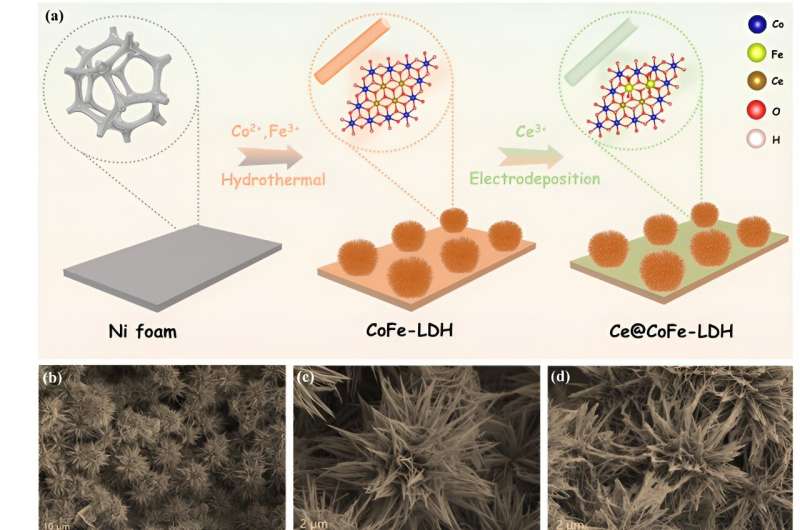This article has been reviewed according to Science X's editorial process and policies. Editors have highlighted the following attributes while ensuring the content's credibility:
fact-checked
proofread
Urchin-like CoFe-layered double hydroxide synthesized for high-efficiency electrocatalytic oxygen evolution

A research team led by Professor Wang Qi from Hefei Institutes of Physical Science, Chinese Academy of Sciences, has successfully synthesized a heterogeneous Ce@CoFe-LDH electrocatalyst by combining a simple hydrothermal method with rapid electrodeposition.
The results were published in Inorganic Chemistry Frontiers.
Electrochemical water splitting is vital for clean hydrogen energy production. The oxygen evolution reaction (OER) in water splitting is slow due to complex electron transfer steps. Noble metal-based nanomaterials like Ru or Ir are effective OER catalysts but face scarcity and stability issues. Developing stable OER electrocatalysts based on transition metals is crucial for large-scale applications.
In this research, by using low concentrations of Ce ions and rapidly depositing them, researchers have successfully created ultrafine Ce(OH)3 nanoparticles that are evenly distributed on the surface of CoFe-LDH nanowires.
This formation results in the generation of numerous stable active interfaces. The exchange of electrons between ultrafine Ce(OH)3 nanoparticles and CoFe-LDH nanowires produces an optimal electronic structure on CoFe-LDH's surface. Consequently, Ce@CoFe-LDH demonstrates remarkable efficiency and stability in facilitating OER.
Moreover, through interface engineering, the energy barrier for the rate-determining step (RDS) of the reaction is reduced, resulting in enhanced catalytic performance and stability.
Furthermore, Ce@CoFe-LDH exhibits superior performance compared to commercial RuO2 anodes in water splitting, significantly advancing the commercialization prospects of electrocatalytic water splitting technology.
This study provides new ideas on how to make electrocatalysts that work well for OER so that water can be split on a big scale for clean energy and environmental reasons, according to the team.
More information: Xuxu Sun et al, Interface-engineered urchin-like CoFe-layered double hydroxide for high-efficiency electrocatalytic oxygen evolution, Inorganic Chemistry Frontiers (2023). DOI: 10.1039/D3QI02220J
Provided by Hefei Institutes of Physical Science, Chinese Academy of Sciences





















